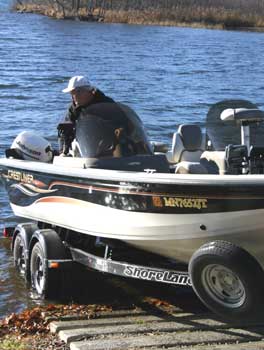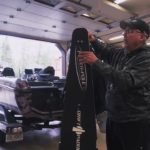On the Road Again

So you’re looking for your first boat, and it’s a dandy. Or you’re thinking about trading up and getting into a new model that will deliver more comfort and fuel efficiency. One thing’s for sure, there is plenty to choose from. When you add up everything that’s available ( along with all the options ), the process can be a little mind boggling and may require some intensive thought and study. With most of the attention being focused on the details, it’s easy for buyers to overlook one of the most important aspects of their perfect rig; the trailer.
It’s easy to overlook because there really isn’t a lot of glitz associated with a trailer, it’s just something you have to have. Although a trailer isn’t going to help you catch more fish or smooth out a rough ride, it will get you to where you’re going and back again ( if you’re properly rigged ), and do it time after time.
Getting to your destination and back again is important, and a key component to a quality experience.
According to Lance Hendrickson from ShoreLand’r Trailers; ” One of the most important things to keep in mind when looking at a new trailer is making sure you don’t undersize it. Try to envision everything you might bring along and add it all up and should include gear, batteries, a full live well and a full tank of gas.
An overloaded trailer can cause uneven tire wear and may even result in a bent axle and may seriously shorten the expected life of your trailer. Another important thing to look at is the tires, and radials are a must. Radials pull much more smoothly and not a place to try and scrimp. You should also look at the finish, and you really need something that will last. The longest lasting and most durable finish is produced by using a powder coat paint process and can help keep your trailer looking great for years to come.”
As simple as trailers may seem there are a few options to consider when taking a look at the undercarriage of your “perfect” rig. One of the first is a bunk or roller option and is more of a personal preference, although boat manufacturers may suggest otherwise. The general consensus is that a bunk trailer will give a boat hull better support and reduce fatigue and wear, thus increasing the useful life of your rig. That may be so, but a bunk trailer takes more water to unload than a roller does, and if you plan on using any unimproved accesses a roller trailer may be the best way to go.
 A boat on a bunk trailer has to be floated off, and there aren’t any options. If you’ve backed in as far as you dare and haven’t floated your boat you’re out of luck. A roller trailer on the other hand can be unloaded anywhere, including a perfectly dry cement parking lot or ramp, so be careful. Don’t unhook your rig until you’re positioned to drop the boat in the water, and keep an eye on anybody trying to give you a hand as they may not understand the ramifications of a bow clip that has been prematurely loosened.
A boat on a bunk trailer has to be floated off, and there aren’t any options. If you’ve backed in as far as you dare and haven’t floated your boat you’re out of luck. A roller trailer on the other hand can be unloaded anywhere, including a perfectly dry cement parking lot or ramp, so be careful. Don’t unhook your rig until you’re positioned to drop the boat in the water, and keep an eye on anybody trying to give you a hand as they may not understand the ramifications of a bow clip that has been prematurely loosened.
The trend in walleye and bass rigs has been the move to bigger and longer boats, thus increasing overall comfort. The problem with this trend is the space limitations that the common garage size presents. To help overcome at least part of the problem manufacturers have developed models available with swing away tongues, which can reduce the overall length of your parked rig by up to two feet.
The swing away tongue is simply a hinge and clip built in to the forward portion of the trailer tongue that when released allows a chunk of the trailer to be folded back and out of the way. The hinge and clip has no adverse effect on the performance of the trailer and can make the difference between getting the rig you really want or one that simply fits.
Today’s bigger and longer rigs have special requirements, including brakes that will help get the whole thing stopped when you really need to be stopped. Trailers with capacities of 3,000 lbs or more legally have to have brakes, and are always a good idea. According to Hendrickson “Make sure the trailer you’re looking at has disc breaks as they require the least amount of maintenance and provide the utmost in breaking power”.
Once you’ve put it all together and are heading home with a brand new rig you might do yourself a favor and schedule a little time getting comfortable with backing it up. Sooner or later you’re going to have to back up, and doing so for the first time at the public access is probably not the best way to go. Even if you’re adept at backing up a new longer rig is going to have different handling characteristics and something you’ll want to get familiar with.
If you’re a novice, it’d be a good idea to set up a practice course in a vacant parking lot or in my case; an open field. By setting up a couple of cones and learning to back your rig safely between them, you’ll save yourself some time when it comes to the real thing. When my son’s wanted to use my prized possession for the first time I had them set up “the course” in our pasture and practice until they became comfortable with the whole affair.
By practicing under these conditions you can avoid the pressure of doing so in front of a crowd of people that are impatiently waiting and hoping for you to get it right. If you’re learning to back up for the first time take it slow as a trailer out of control can quickly jack knife and may result in a bent tongue. A bent tongue won’t trail properly, and you’ll end up with tires that wear unevenly and prematurely meet their demise.
If you take the time to learn how to back up a trailer, you might as well go the extra mile and learn to do so by using your mirrors. It will take more time, but there are going to be situations where you simply can’t see the boat or where it’s going by looking out the back window. It will feel a little strange at first as the trailer will react the opposite of what you might expect, but you will get it right if you stick with it. See you at the ramp.





